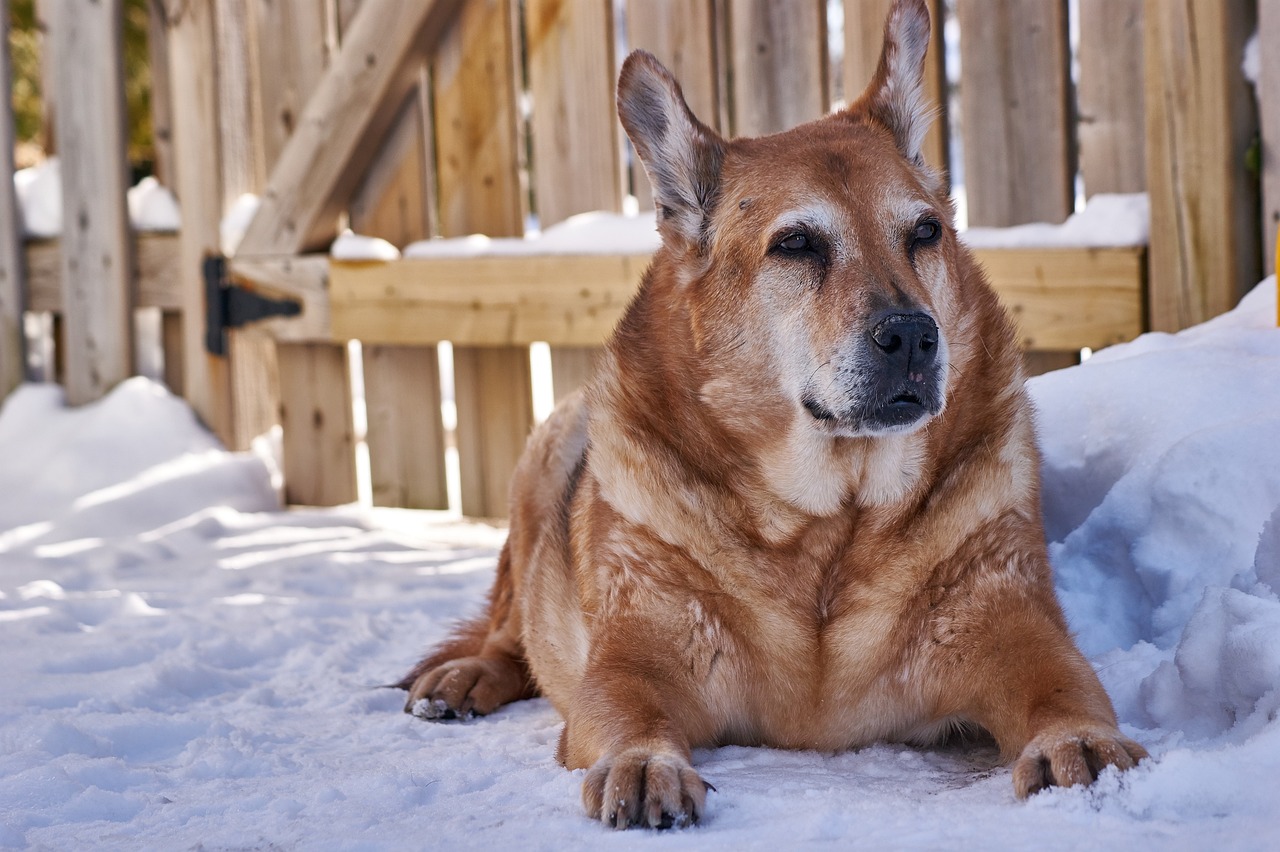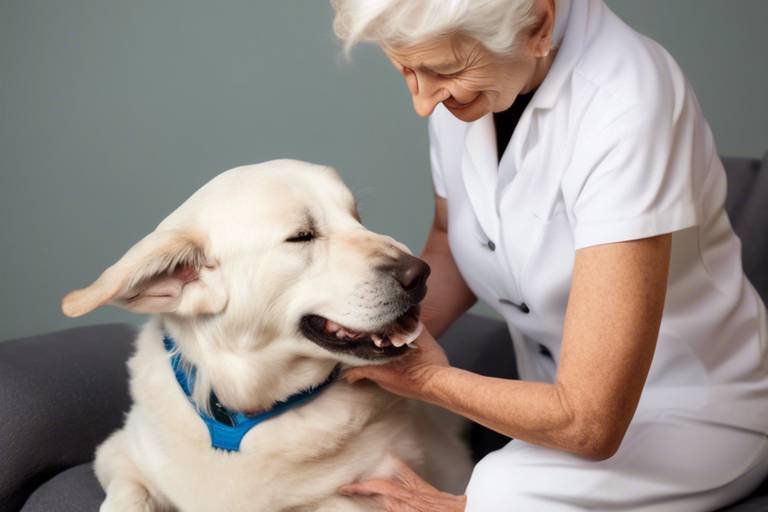Tips for Keeping Your Senior Pet Engaged
As our beloved furry friends age, it's essential to adapt our approach to their care. Just like us, senior pets experience changes in their physical and mental capabilities, which can affect their overall happiness and well-being. Keeping your senior pet engaged is not just a matter of fun; it’s about ensuring they lead a fulfilling life in their golden years. From interactive toys to mental stimulation activities, there are numerous ways to keep those tails wagging and those purrs coming!
As pets age, their physical and mental needs change significantly. Understanding these shifts is crucial for providing appropriate care and engagement. For instance, older pets may not have the same energy levels they once did, and they might require more frequent breaks during play. Additionally, their senses, especially sight and hearing, may decline, making it vital to modify activities accordingly. By recognizing these changes, you can tailor your approach to ensure your furry companion maintains a high quality of life. After all, wouldn’t you want to be treated with the utmost care and respect as you age?
Engaging your senior pet with interactive toys and games can stimulate their mind and body. Think of it as a workout for their brain! There are various options available that cater to their physical capabilities while keeping them entertained. For example, toys that dispense treats can motivate your pet to play while rewarding them, making the experience enjoyable. Additionally, gentle tug toys or soft balls can encourage light exercise without putting too much strain on their joints.
Selecting toys designed specifically for senior pets is essential. Look for options that are gentle on their teeth and easy to manipulate. This not only promotes safe play but also ensures that your pet remains engaged without causing stress or injury. Remember, the goal is to keep their spirits high and their bodies active. So, whether it’s a plush toy or a soft rubber ball, choose wisely!
Creating homemade toys can be a fun and cost-effective way to keep your senior pet engaged. Simple materials can be transformed into stimulating activities that cater to their unique preferences and abilities. For instance, an old sock filled with crinkly plastic can become an exciting toy! Just be sure to supervise your pet during playtime to ensure safety.
Participating in games with your senior pet not only keeps them active but also strengthens your bond. Discover simple activities that can be adapted to their physical limitations. For example, playing a gentle game of fetch in a soft grassy area can be both fun and safe. You might also consider hide-and-seek, where you hide treats around the house for them to find. This not only provides physical activity but also mental stimulation!
Establishing a consistent exercise routine is vital for senior pets. Tailoring activities to their energy levels can help maintain their physical health and prevent obesity, contributing to their overall well-being. A simple daily walk, even if it’s just around the block, can do wonders. It’s not just about physical exercise; it’s also a chance for them to explore and enjoy the world around them. Remember, even small bursts of activity can make a big difference!
Mental engagement is just as important as physical exercise for senior pets. Explore various activities that challenge their cognitive abilities and keep their minds sharp. Just like us, pets thrive on stimulation and routine. Activities like scent games, where they have to find hidden treats using their nose, can provide a fantastic mental workout. This not only keeps them entertained but also fosters a sense of accomplishment and joy.
Teaching new tricks or reinforcing old ones can provide great mental stimulation. Discover methods for training senior pets that are gentle and rewarding. Positive reinforcement is key here! Use treats and praise to encourage your pet, making training a fun and enjoyable experience. It’s never too late to learn something new, and who knows, you might just impress your friends with your pet’s new skills!
Using puzzle feeders can turn mealtime into an engaging activity. These feeders require your pet to work for their food, stimulating their minds while encouraging a healthy eating pace. Not only does this prevent boredom, but it also helps to slow down fast eaters, reducing the risk of digestive issues. Plus, watching them figure out how to get to their treats can be quite entertaining!
- How often should I engage my senior pet in activities? It's best to engage them daily, but tailor the activities to their energy levels.
- What are some signs my senior pet is not enjoying an activity? Look for signs of fatigue, disinterest, or discomfort. Always prioritize their comfort!
- Can I use regular toys for my senior pet? Yes, but ensure they are safe and suitable for their age and physical condition.

Understanding Senior Pet Needs
As our beloved pets age, their physical and mental needs undergo significant changes. It's like watching a vibrant flower slowly transition into a beautiful yet delicate bloom. Understanding these shifts is crucial for providing the right care and engagement, ensuring they maintain a high quality of life in their golden years. Just like humans, senior pets can experience a range of challenges, including decreased mobility, vision and hearing impairments, and cognitive decline. So, how can we adapt to these changes and keep our furry friends happy and healthy?
First and foremost, it's essential to recognize that senior pets often require more attention and patience. Their energy levels may drop, and they might not be as spry as they once were. However, this doesn't mean they don’t enjoy playtime or interaction; it just means we need to tailor our approach. For instance, shorter play sessions with gentle activities can be more beneficial than intense exercise. Think of it as swapping a marathon for a leisurely stroll in the park!
Moreover, senior pets may develop certain health conditions that affect their behavior and needs. Conditions such as arthritis can make jumping or running painful, while cognitive dysfunction syndrome can lead to confusion and anxiety. Therefore, keeping a close eye on their behavior and being attuned to their needs is vital. Regular vet check-ups are paramount, as they can help identify any underlying health issues early on. Just like a well-tended garden needs regular care, our senior pets require consistent attention to thrive.
Another important aspect to consider is their dietary requirements. As pets age, their metabolism slows down, and they may require a diet that is lower in calories but higher in essential nutrients. This can help prevent obesity, which is a common problem in senior pets. Consulting with a veterinarian about the best diet can make a world of difference in maintaining your pet's health. Remember, a well-fed pet is a happy pet!
Lastly, mental stimulation is just as crucial as physical exercise. Engaging their minds can help stave off cognitive decline and keep their spirits high. Activities like puzzle toys, gentle training sessions, and interactive games can keep their brains sharp and their hearts happy. Just think of it as giving them a mental workout—something every pet deserves!
| Common Senior Pet Needs | Signs to Look For |
|---|---|
| Decreased Mobility | Struggling to get up or move around |
| Cognitive Decline | Disorientation or changes in behavior |
| Dietary Changes | Weight gain or loss, changes in appetite |
| Increased Sensitivity | Changes in temperament or irritability |
In summary, understanding the unique needs of senior pets is an ongoing journey that requires love, patience, and adaptability. By being aware of their physical and mental changes, we can create a nurturing environment that allows them to thrive in their golden years. After all, our senior companions have given us so much joy over the years; it’s only right that we return the favor!
- What age is considered senior for pets? Typically, pets are considered senior when they reach around 7 years old, but this can vary by breed and size.
- How can I tell if my senior pet is in pain? Look for signs such as limping, reluctance to move, changes in appetite, or unusual vocalizations.
- Are there specific diets for senior pets? Yes, senior pet diets are formulated to be lower in calories but higher in fiber and essential nutrients.
- How much exercise does a senior pet need? Exercise needs vary, but shorter, more frequent walks or gentle playtime can be beneficial.

Interactive Toys and Games
Keeping your senior pet engaged is crucial for their overall well-being, and one of the most enjoyable ways to do this is through . These tools not only provide entertainment but also stimulate your pet's mind and body, making them feel more alive and vibrant. Imagine your furry friend’s tail wagging with excitement as they discover new ways to play! The right toys can turn a dull day into an adventure, sparking joy and keeping their spirits high.
When selecting interactive toys, it’s important to consider your pet's physical capabilities. For instance, some senior pets may have arthritis or reduced mobility, so look for toys that are gentle on their joints and easy to manipulate. Soft, plush toys with squeakers can provide comfort and engagement without putting too much strain on their bodies. Additionally, toys that encourage gentle chewing can help maintain oral health while keeping them entertained.
There are various types of interactive toys available, from treat-dispensing puzzles to simple tug toys. For example, a puzzle feeder can turn mealtime into a fun challenge, encouraging your pet to work for their food. This not only slows down their eating pace but also keeps their mind sharp, as they figure out how to access the treats hidden inside. You might be surprised at how quickly your pet can become a little mastermind!
When it comes to choosing the right toys for your senior pet, focus on durability and safety. Look for toys made from non-toxic materials and avoid anything with small parts that could pose a choking hazard. It’s also wise to select toys that are easy to clean, as senior pets may have accidents or drool more than their younger counterparts. Remember, you want to create a safe play environment that encourages exploration and fun!
If you're feeling crafty, consider creating your own interactive toys using simple household items. For example, you can take an old sock, fill it with some crinkly paper, and tie it off to create a fun, noise-making toy. Alternatively, you can make a treat-dispensing ball by cutting small holes in a plastic bottle, filling it with your pet's favorite treats, and letting them figure out how to get the goodies out. These DIY toys can provide endless entertainment and are often more engaging than store-bought options.
Don’t forget that playing games with your senior pet can strengthen your bond while keeping them active. Simple games like hide-and-seek can be adapted for older pets. You can hide somewhere in your home and call your pet to come find you, rewarding them with praise or a treat when they do. This not only keeps them physically active but also mentally stimulated as they navigate through the house. Another fun idea is to play a gentle version of fetch using a soft toy, allowing your pet to chase it at their own pace.
In conclusion, incorporating interactive toys and games into your senior pet's daily routine is a fantastic way to enhance their quality of life. By choosing the right toys, creating DIY options, and engaging in fun games together, you can ensure that your furry friend remains happy, healthy, and mentally stimulated as they age. Who knew that keeping your pet engaged could be so much fun?
Q: How often should I play with my senior pet?
A: It's ideal to engage with your senior pet daily, but the intensity and duration of play should be tailored to their energy levels. Short, frequent play sessions are often more beneficial than longer, strenuous ones.
Q: Are there specific toys I should avoid for senior pets?
A: Yes, avoid toys that are too hard or have small parts that could be swallowed. Opt for softer, larger toys that are easy to grip and manipulate.
Q: Can interactive toys help with my pet's anxiety?
A: Absolutely! Interactive toys can distract and engage your pet's mind, helping to alleviate feelings of anxiety and boredom. They provide a constructive outlet for their energy.
Choosing the Right Toys
When it comes to keeping your senior pet engaged, is absolutely essential. As our furry friends age, their physical capabilities and preferences often change, making it crucial to select toys that are not only entertaining but also safe and suitable for their needs. Imagine trying to play fetch with a senior dog who can barely run; it’s not just ineffective, it can also be disheartening for both of you. Instead, opt for toys that encourage gentle play and stimulate their senses without overwhelming them.
One of the first things to consider is the material of the toys. Look for options that are soft yet durable, as senior pets may have sensitive teeth and gums. Rubber or plush toys can be a great choice, as they provide a satisfying chew without causing discomfort. Additionally, toys that are easy to grip and manipulate will help keep your pet engaged without straining their joints. Think of it like choosing the right pair of shoes; you want something comfortable yet functional that allows for movement.
Another important aspect is the size of the toys. Ensure that they are appropriately sized for your pet to prevent any choking hazards. For instance, a toy that is too small can easily become a choking risk, while one that is too large may be difficult for them to handle. A good rule of thumb is to choose toys that are about the size of your pet's mouth, allowing them to chew and play without frustration.
Here are some types of toys to consider when selecting the best options for your senior pet:
- Interactive Toys: Toys that require your pet to think and engage, such as treat-dispensing toys, can keep their minds sharp.
- Soft Plush Toys: These are perfect for cuddling and gentle play, making them ideal for older pets who enjoy comfort.
- Chew Toys: Look for gentle chew toys that are easy on the teeth but still provide a satisfying texture for chewing.
Finally, don’t forget to observe your pet’s behavior with new toys. Just like humans, pets have their own unique preferences. Some may love to tug and chew, while others might prefer to snuggle or carry their toys around. Pay attention to what excites them and adjust your choices accordingly. Remember, the goal is to enhance their playtime experience, so be flexible and willing to try different options until you find the perfect fit.
Q: How can I tell if a toy is safe for my senior pet?
A: Always check for small parts that could be a choking hazard, and ensure the materials are non-toxic and suitable for your pet's chewing habits.
Q: Are there specific brands recommended for senior pet toys?
A: While there are many brands, look for those that specialize in senior pet products, as they often consider the unique needs of older animals.
Q: How often should I replace my senior pet's toys?
A: Regularly inspect toys for wear and tear. If they show significant signs of damage, it’s time to replace them to ensure your pet’s safety.
DIY Toy Ideas
Creating homemade toys for your senior pet can be a delightful and rewarding experience, both for you and your furry friend. Not only does it allow you to customize the toys to suit their specific needs and preferences, but it also provides an opportunity to bond through play. The best part? You can often use materials you already have at home, making it a cost-effective solution for keeping your pet engaged.
One simple yet effective idea is to make a treat-dispensing toy. You can take an empty plastic bottle, remove the label, and cut a few holes in it. Fill the bottle with your pet's favorite treats or kibble, and watch as they roll it around to get the goodies out. This not only stimulates their mind but also encourages them to be active. Just be sure the bottle is safe for them to chew on, and supervise them during playtime to prevent any accidents.
Another fun DIY project is to create a snuffle mat. This is essentially a mat made of fabric strips tied to a base, where you can hide treats within the folds. It encourages your pet to use their sense of smell and natural foraging instincts. To make one, you can use a rubber mat and some fleece fabric. Cut the fleece into strips and tie them onto the mat, leaving plenty of space to tuck treats in. This activity can keep your senior pet busy and mentally stimulated for hours!
If your senior pet enjoys tug-of-war games, consider making a tug toy from old t-shirts or towels. Simply cut the fabric into strips, braid them together, and tie off the ends. This toy is soft enough for their teeth and can be customized in size to suit your pet's strength. Just remember to supervise tugging sessions to ensure that playtime remains safe and enjoyable.
Lastly, don't underestimate the value of a simple cardboard box. You can create a mini obstacle course or hide treats inside for your pet to discover. Cardboard is easy to manipulate and can be a safe option for pets who might be prone to chewing. Just ensure there are no small pieces they can swallow, and keep an eye on them while they explore their new play area.
By engaging in these DIY projects, you not only provide your senior pet with stimulating toys but also create lasting memories as you craft and play together. It's a win-win situation that enriches their life while strengthening your bond!
Q: How can I ensure the DIY toys are safe for my senior pet?
A: Always supervise your pet while they play with DIY toys. Use non-toxic materials and avoid small parts that could be swallowed. Regularly inspect the toys for wear and tear, and discard any that become unsafe.
Q: What if my senior pet is not interested in the DIY toys?
A: It may take some time for your pet to warm up to new toys. Try engaging them with treats or playtime to spark their interest. You can also experiment with different types of toys to find what they enjoy most.
Q: How often should I rotate the toys?
A: Rotating toys every few days can keep your pet's interest alive. Just like children, pets can get bored with the same toys. By introducing "new" toys regularly, you can maintain their excitement and engagement.
Games to Play Together
Engaging in games with your senior pet is not just about keeping them active; it's a wonderful way to strengthen the bond you share. Think of it as a dance where both partners need to be in sync, adjusting to each other's pace and energy. While your senior companion may not be able to jump as high or run as fast as they once did, there are still plenty of fun activities that can keep their spirits high and their bodies moving.
One of the simplest and most enjoyable games you can play is a gentle game of fetch. Instead of tossing a ball across the yard, opt for a soft toy that’s easy for them to carry. You can even modify the distance to accommodate their energy levels. If your senior pet is a dog, you might find that they enjoy a slow-paced game of fetch in a cozy corner of your living room or backyard. This way, they can still participate without overexerting themselves.
Another fantastic option is hide-and-seek. This game isn’t just for kids! You can hide in a different room and call your pet’s name. The excitement of finding you can spark their curiosity and enthusiasm. For added fun, you can hide their favorite toy or treat and encourage them to sniff it out. This not only engages their mind but also taps into their natural instincts.
If your pet enjoys puzzles, consider creating a scavenger hunt. Hide treats around your home or yard and encourage them to find them. Just like a treasure hunt, this activity can keep them entertained while providing mental stimulation. Make sure to use treats that are easy for them to chew and digest, keeping their health in mind.
For those pets that love a bit of agility, you can set up a simple obstacle course using household items. Use cushions, boxes, or low furniture to create a safe path for them to navigate. This encourages physical activity and can be a fun challenge without being too strenuous. Remember, it’s all about adapting the game to suit your pet’s unique abilities and limitations.
Lastly, don’t underestimate the power of simple interactive play. Engaging in gentle tug-of-war with a soft rope toy can be a delightful way to interact. Just be sure to let your pet win occasionally; this boosts their confidence and keeps the game fun. Always keep an eye on their energy levels and stop if they seem tired or disinterested.
In summary, playing games with your senior pet can be a delightful experience filled with joy and laughter. Whether it’s a gentle game of fetch, hide-and-seek, or a scavenger hunt, the key is to keep it light and fun. Each interaction not only helps maintain their physical health but also enhances their mental well-being. So grab a toy, get creative, and make some lasting memories with your beloved companion!
- What types of games are suitable for senior pets? Gentle fetch, hide-and-seek, scavenger hunts, and simple obstacle courses are great options.
- How can I tell if my senior pet is tired during play? Watch for signs like heavy panting, slowing down, or disinterest in the game.
- Are there specific toys I should avoid for senior pets? Yes, avoid toys that are too hard or small, which could pose a choking hazard or risk of dental injury.
Regular Exercise Routines
Establishing a consistent exercise routine is vital for senior pets. Just like us, our furry friends need to stay active to maintain their health and happiness as they age. But here's the thing: as pets grow older, their energy levels and physical capabilities can change significantly. This means that what worked for them in their younger days might not be suitable anymore. So, how do we find that perfect balance between keeping them active and respecting their limitations?
First off, it's essential to tailor activities to your senior pet's individual needs. You wouldn't throw a 90-year-old person into a marathon, right? The same logic applies here. Start by observing your pet's current activity level and any signs of discomfort or fatigue. This can help you determine what kind of exercises are appropriate. For instance, if your dog enjoys short walks but gets tired quickly, consider breaking those walks into several shorter sessions throughout the day. This approach not only keeps them active but also prevents overexertion.
Here are some enjoyable activities that you can incorporate into your senior pet’s exercise routine:
- Gentle Walks: Short, leisurely walks can provide great physical activity without overwhelming your pet.
- Swimming: If your pet enjoys water, swimming is a fantastic low-impact exercise that’s easy on their joints.
- Interactive Play: Engage your pet with soft toys or gentle games of fetch that encourage movement without causing stress.
- Obstacle Courses: Set up a simple course in your living room or yard using household items. This can stimulate both their mind and body.
Moreover, consider integrating some light stretching or agility exercises into their routine. Just like humans, pets can benefit from a little flexibility training. You can encourage gentle stretches by using treats to guide them into positions that promote flexibility and joint health. Not only will this help maintain their physical condition, but it can also be a great bonding experience between you and your pet.
To keep things fresh and exciting, don’t hesitate to mix up the activities. Variety is the spice of life, after all! You might even find that your pet enjoys trying new things. Keep an eye on their reactions and adjust accordingly. If they seem to enjoy a particular activity, incorporate it more often into their routine.
Lastly, always remember to provide plenty of positive reinforcement. Celebrate their achievements, no matter how small they may seem. Whether it’s a wagging tail after a short walk or a gentle nudge for more playtime, those moments of joy and connection can make all the difference in your senior pet's life.
Q: How often should I exercise my senior pet?
A: It depends on your pet's individual needs, but generally, short sessions of exercise multiple times a day are ideal. Aim for 15-30 minutes of activity, adjusted for their comfort level.
Q: What if my pet has mobility issues?
A: Consult your veterinarian for tailored advice, but consider low-impact activities like swimming or gentle stretching. Always prioritize their comfort and safety.
Q: Can I use toys to encourage exercise?
A: Absolutely! Interactive toys can stimulate your pet's mind and body. Look for options that suit their physical capabilities.
Q: How can I tell if my pet is overexerted?
A: Watch for signs like excessive panting, reluctance to continue, or limping. If you notice any of these, it’s best to take a break and let them rest.

Mental Stimulation Activities
Mental engagement is just as crucial as physical exercise for our beloved senior pets. As they age, their cognitive abilities may decline, leading to boredom and even behavioral issues. By incorporating into their daily routine, you can enhance their quality of life and help keep their minds sharp. Think of it as a workout for their brains—just like we need to stay mentally fit, our furry friends do too!
There are numerous ways to challenge your pet's intellect while also providing them with fun and engaging experiences. One effective method is through training and tricks. You might be surprised to learn that senior pets are still capable of learning new commands or tricks, even if they may take a little longer to grasp them. Training sessions can be short and sweet, filled with positive reinforcement. Using treats or their favorite toys as rewards can turn these sessions into a delightful game, fostering a sense of accomplishment for both you and your pet.
Another fantastic way to stimulate your senior pet's mind is through puzzle feeders and treat-dispensing toys. These clever gadgets not only make mealtime exciting but also challenge your pet to think critically about how to get to their food. Imagine your pet's joy as they figure out how to roll, nudge, or flip the feeder to access their treats. It's like a treasure hunt that keeps them engaged and mentally active. When selecting a puzzle feeder, consider their physical abilities; some may require more dexterity than others, so choose one that suits your pet's needs.
Engaging in these mental stimulation activities can significantly reduce the risk of cognitive decline and enhance your pet's overall happiness. By keeping their minds active, you're not just filling their day with fun; you're also providing them with a sense of purpose and achievement. So, grab those treats, pull out the puzzle feeders, and get ready to watch your senior pet thrive!
Here are some common questions pet owners have regarding mental stimulation activities for senior pets:
- How often should I engage my senior pet in mental activities? Aim for at least 15-30 minutes of mental stimulation daily, broken into shorter sessions if needed.
- Are there specific games that are better for senior pets? Yes, games that involve gentle physical activity and cognitive challenges, like hide and seek or simple fetch, are great options.
- Can mental stimulation help with behavioral issues? Absolutely! Keeping their minds engaged can reduce anxiety and destructive behaviors stemming from boredom.
Training and Tricks
Training your senior pet can be a rewarding experience, not just for them but for you as well. It’s a wonderful way to strengthen the bond between you and your furry friend, while also providing them with essential mental stimulation. Remember, just because your pet is older doesn’t mean they can’t learn new tricks! In fact, engaging their minds can help keep them sharp and alert.
When approaching training for senior pets, it's crucial to use gentle methods that respect their physical limitations. Think of it like teaching a grandparent how to use a smartphone; you wouldn’t throw them into a complex tutorial without first covering the basics. Start with simple commands that they may already know, like “sit” or “stay,” and gradually introduce new ones at a pace that suits them. Positive reinforcement is key here. Use treats, praise, and affection to reward their efforts, making sure they associate learning with positive experiences.
Consider incorporating short training sessions into your daily routine. These can be as brief as 5-10 minutes, which is often enough to keep their attention without overwhelming them. You might be surprised at how quickly they pick up new tricks! For instance, teaching them to fetch a specific toy can be both fun and mentally engaging. Also, don’t forget to celebrate their successes, no matter how small. A simple “good job!” can go a long way in boosting their confidence.
Moreover, you can introduce games that involve problem-solving. For example, hide treats around the house and encourage your pet to sniff them out. This not only taps into their natural instincts but also provides a stimulating challenge that keeps their minds active. Just like how we enjoy solving puzzles or playing brain games, your senior pet will appreciate the mental workout, and you’ll enjoy watching them work through the challenges!
Here’s a quick table summarizing some effective training techniques for senior pets:
| Technique | Description | Benefits |
|---|---|---|
| Positive Reinforcement | Rewarding desired behavior with treats or praise. | Encourages learning and builds trust. |
| Short Sessions | Keeping training sessions brief and focused. | Prevents fatigue and keeps them engaged. |
| Interactive Games | Playing games that require problem-solving. | Stimulates mental activity and natural instincts. |
In conclusion, training your senior pet is not just about teaching them new tricks; it’s about enhancing their quality of life through engagement and interaction. So, grab some treats, find a comfortable spot, and enjoy the delightful journey of learning together!
Q: Can senior pets learn new tricks?
A: Absolutely! While they may take a little longer to learn, senior pets are capable of picking up new tricks with patience and positive reinforcement.
Q: How long should training sessions be for senior pets?
A: Keep training sessions short, around 5-10 minutes, to prevent fatigue and maintain their interest.
Q: What types of rewards are best for training senior pets?
A: Use soft treats, praise, and affection as rewards. Ensure the treats are easy for them to chew.
Q: Are there any specific tricks that are easier for senior pets to learn?
A: Yes! Tricks like “sit,” “shake,” and “come” are generally easier and can be taught progressively.
Puzzle Feeders and Treats
Puzzle feeders are a fantastic way to transform your senior pet's mealtime into an engaging and mentally stimulating experience. Imagine your furry friend not just gobbling down their food, but actually working for it! This not only makes eating more exciting but also encourages them to think and problem-solve, which is essential for keeping their minds sharp as they age.
When selecting a puzzle feeder, consider your pet's physical abilities. Some feeders require more dexterity than others, so it's important to choose one that aligns with your senior pet's capabilities. For instance, if your pet has arthritis or limited mobility, opt for feeders that are easier to manipulate, ensuring that they can enjoy the challenge without frustration. Look for options that are adjustable, allowing you to increase or decrease the difficulty level as your pet becomes more adept at using it.
Here are a few tips for using puzzle feeders effectively:
- Start Slow: If your pet is new to puzzle feeders, begin with simpler designs that require minimal effort. Gradually increase the difficulty as they become more comfortable.
- Incorporate Treats: Use your pet's favorite treats to entice them to engage with the feeder. This not only makes it more appealing but also motivates them to keep trying.
- Supervise Initially: Keep an eye on your pet the first few times they use the puzzle feeder to ensure they are safe and not becoming overly frustrated.
Additionally, puzzle feeders can help in slowing down fast eaters, which is a common issue among pets. By forcing them to work for their food, they are less likely to gulp it down, leading to better digestion and overall health. You might even notice a change in their behavior; they may become more focused and attentive, showcasing their excitement as they solve the puzzle. This mental engagement is crucial, especially for senior pets who may be prone to cognitive decline.
Incorporating puzzle feeders into your pet's routine can also be a great way to bond. You can sit nearby, offering encouragement as they figure out how to get to their treats. This shared experience not only strengthens your relationship but also provides them with the emotional support they need as they navigate their golden years.
In conclusion, puzzle feeders are more than just a feeding tool; they are a means of enriching your senior pet's life. By stimulating their minds and providing a fun challenge, you are helping to keep them engaged and happy. So, why not give it a try? Your senior pet will thank you with wagging tails or gentle purrs!
Q: Are puzzle feeders suitable for all senior pets?
A: While puzzle feeders can be beneficial for many senior pets, it's important to choose one that matches their physical abilities and cognitive function. Always supervise their first attempts to ensure they're comfortable.
Q: How often should I use a puzzle feeder?
A: You can incorporate a puzzle feeder into your pet's routine a few times a week or daily, depending on their interest and energy levels. Just be sure to adjust the difficulty as needed.
Q: Can I use puzzle feeders for treats instead of regular meals?
A: Absolutely! Puzzle feeders can be filled with treats to provide mental stimulation without replacing their regular meals. Just be mindful of their overall calorie intake.
Frequently Asked Questions
- What are some signs that my senior pet needs more engagement?
If your senior pet seems lethargic, disinterested in activities they once enjoyed, or exhibits behavioral changes like increased barking or whining, it might be time to amp up their engagement. Look for signs of boredom or restlessness, as these can indicate that they need more stimulation in their daily routine.
- How can I choose the right toys for my senior pet?
When selecting toys for your senior pet, prioritize options that are soft and easy to handle. Look for toys that are designed specifically for older pets, as they often have features that accommodate sensitive teeth and joints. Always consider your pet's specific needs and preferences to ensure they enjoy playtime!
- Are there any safe DIY toy ideas for senior pets?
Absolutely! You can create simple toys using household items. For example, a crumpled paper ball can be a fun and engaging toy for a cat, while a sock filled with catnip can delight both cats and dogs. Just make sure any materials used are safe and free from small parts that could be swallowed.
- What types of games can I play with my senior pet?
Games like gentle fetch, hide and seek, or simple tug-of-war can be great options for keeping your senior pet active. Tailor the intensity to their physical capabilities, ensuring they have fun without overexerting themselves. Remember, the goal is to strengthen your bond while keeping them engaged!
- How much exercise does my senior pet need?
The amount of exercise varies by pet, but generally, short walks or play sessions several times a day are beneficial. Aim for about 20-30 minutes of light activity, adjusting based on their energy levels and health condition. Regular movement helps maintain their physical health and keeps them happy!
- What mental stimulation activities can I do with my senior pet?
Consider engaging your pet in training sessions, where you can teach them new tricks or reinforce old ones. Puzzle feeders are also a fantastic way to challenge their minds during mealtime, turning a basic routine into a fun and stimulating activity!
- How do puzzle feeders work for senior pets?
Puzzle feeders are designed to make mealtime more interactive. They require your pet to solve a challenge to access their food, which stimulates their brain and slows down their eating pace. Just ensure the feeder is suitable for your pet's size and capabilities to maximize their enjoyment!



















